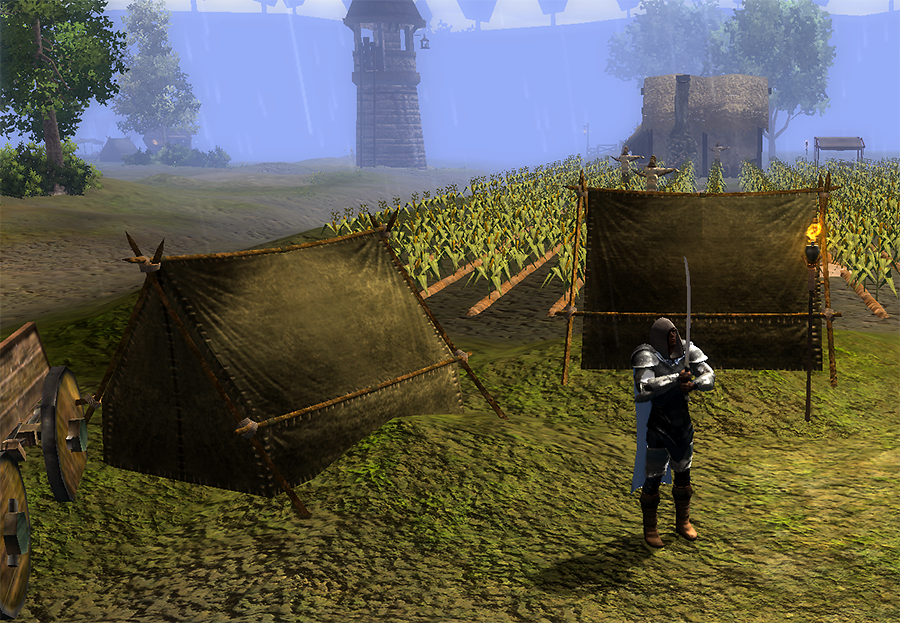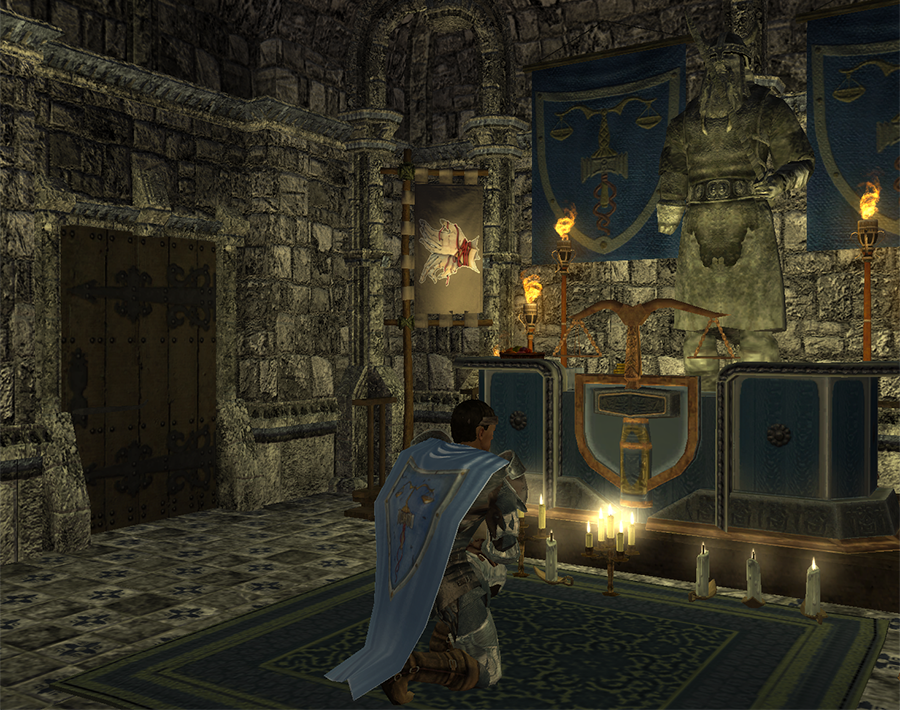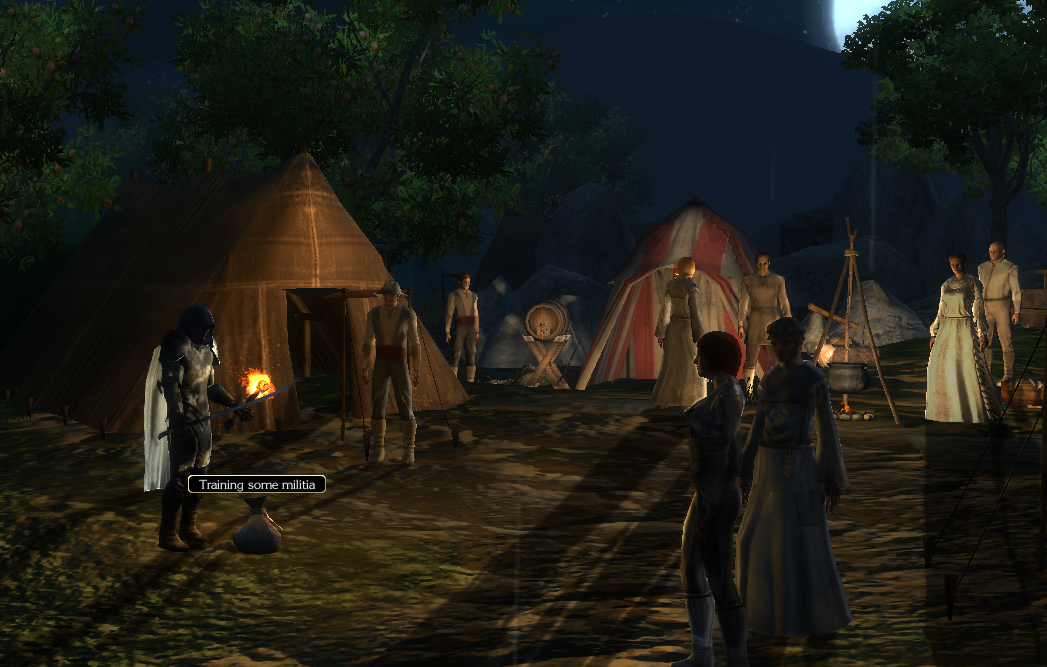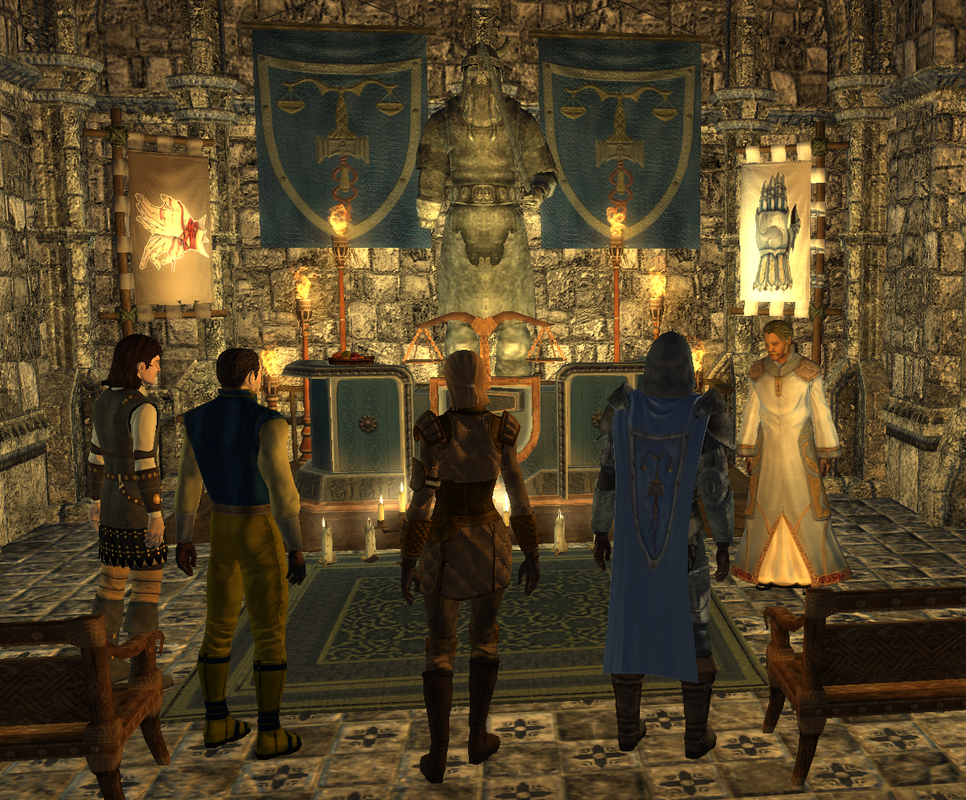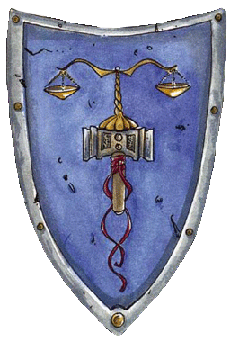
Reveal the truth, punish the guilty, right the wrong,
and be always true and just in your actions.
Based in the city of Baldur's Gate
~
Tyr
(The Even-Handed, Grimjaws, the Maimed God, the Blind Overlord, the Wounded One, the Just God)
Symbol: A balanced set of scales set upon the head of an upright warhammer.
When he is depicted in religious art, Tyr (TEER) appears as a noble warrior missing his right hand, lost to Kezef the Chaos Hound in proving his resilience and strength of spirit. In recent years, he has been shown blinded as well, a fatality of the wrath of Ao during the Time of Troubles. Tyr’s symbol shows his nature: justice through benevolent force and armed vigilance. He opposes all beings who deal in trickery, rule-breaking, and unjust destruction or misdeeds. He is said to be a latecomer among the powers of Faerûn, appearing over a millennium ago but after most other Realms powers had established themselves. His faith is popular, as everyone knows exactly what Tyr expects his faithful to do and everyone can trust Tyrrans to be honorable, honest, lust, and righteous.
Tyr is rather enigmatic to those outside his faith. He represents such stern justice that it is difficult to see the more subtle qualities of the god. He is a courageous father figure to his faithful and struggles continually to achieve for his followers a paradisiacal state of affairs in Faerûn that he knows will never come in an imperfect world. In his more affectionate moods, he sometimes refers to his abode in Lunia as the Just House, and one senses from bun at times an odd sort of longing to want to be able to deal with troubles as one could among a perfect family: with love, courage, and the knowledge that everyone will try their best and not betray their fellows because of a special bond that all share. Unfortunately, he also knows that this will never happen, and so emits an undercurrent of stem sadness for what can never be. He is terribly protective of his priesthood, and because of this, he is more likely to manifest in some form to aid them than many other powers.
Torm and Ilmater serve Tyr, and the three deities are sometimes called the Triad.
Holy Manifestations
To denote his favor or the occurrence of important deeds, decisions, or utterances, it is said that Tyr manifests as the echoing, stroke of a gong, accompanied by an exultant wordless chord sung by unseen male voices. Tyr also shows his will through the image of an upright, glowing war hammer accompanied by telekenesis effects that demonstrate the god’s intent and feelings. The hammer may also move, point, strike, or emit spells to further the will of Tyr. In addition, Tyr sometimes acts through extremely obedient, intelligent, large, and well-groomed war dogs that appear out of nowhere.
The Church
While some paladins preferring, a a straight black-and-white choice revere Tyr, he is most popular with the bureaucrats, judges, and merchants who make the entire system move efficiently. Worshipers of Tyr see the world in clear-cut moral terms; they like to see Faerûn firmly cleansed and ordered by laws that are evenly and diligently applied. They are not very tolerant of other world views and do not find parody, mockery, or even questions about their faith amusing. Tyr survives very well in the civilized world, and moat of his temples are in larger cities. He is also worshiped on the Rock of Bral, rumored to be one of the Tears of Selûne.
Tyr has no specialty priests since the Time of Troubles. It is not yet clear why, but some sages are beginning to theorize that he wished to favor none of his clergy members (over the others). The Church of Tyr is a highly organized, formal priesthood that maintains internal rules and a system of fortified temples. At Tyrran temples, the faithful can find lodging, fresh mounts, healing, spell aid, weapons, gear, and holy advice. If a worshiper or priest knows that she or he has stinted in service to the Just One, confession and penance are also available.
Paladins are not part of the clergy, and instead have their own orders that support the church. Level titles used by the clergy—and knights-in-service—in recent years, in order of ascending rank, are: Acolyte of Laws, Solemn Brother/Sister, Lawkeeper, Sword of Tyr, Hammer of Tyr, Vigilant Watcher, Just Captain, Avenger, Master Avenger, Abbot, High Lord Abbot, High Avenger, Knight Commander, Hammer Lord, Defender of Justice, and Keeper of the Balance. Maverick titles are few indeed, as this is a closely regulated priesthood.
Dogma
Novices of Tyr are charged to: “Reveal the truth, punish the guilty, right the wrong, and be always true and just in your actions.” Tyr and his followers are devoted to the cause of justice, to the righting of wrongs and the deliverance of just vengeance. This is not necessarily equality or fairness, as some make the maimed god out to represent, but rather the discovery of truth and the punishment of the guilty. Tyrrans tend to be stiff-necked about theology and to see matters in black and white terms.
Clergy of Tyr are sworn to uphold the law wherever they go, and to punish those wronged under the law. They are to keep complete records of their own rulings, deeds, and decisions. Through these records, a priest’s errors can be corrected, his or her grasp of the laws of all lands can grow and flourish, and lawbreakers can be identified by others. No known injustice done by a Tyrran priest must go unbalanced. Priests of Tyr should also always be vigilant in their observations and anticipations, seeking to see what forces and which beings intend or will cause injustices and threaten law and order in the future. They should then act to prevent such challenges to justice in coming to pass.
In short: Abide by the laws, and let no others break them. Mete out punishment where lawbreaking occurs.
Day-to-day Activities of Tyrrans
Priests of Tyr serve as judge, jury, and executioner in wilderness areas where there is no law but that of the sword. When doing so, their code cleaves fairly close to “an eye for an eye, a tooth for a tooth,” but does adhere to common trade custom leavened by “the mercy of ignorance.” This last means that if a being is truly ignorant of the proper behavior, minor transgressions can be forgiven once with a warning, an explanation of the proper law—and a record of the warning being written down in the priest’s Book of Lawgiving for later distribution to other Tyrrans so that the particular being will not be forgiven a second time.
In civilized areas, Tyrrans (inevitably called “tyrants” behind their backs by nonbelievers) become legal experts and serve as the lawyers of Faerûn by dispensing advice and “speaking for” accused persons in trials. The fees they charge go to the Church of Tyr.
Tyrrans often go about lecturing others on their shortcomings as to following laws, rules, and regulations, but they also serve to fearlessly take complaints about such formalities to the authorities who make such rules. No Tyrran will enforce a law that contradicts other laws or can be shown to be unjust. Note the concern IS not that it is unfair, but unjust — defined in the Tyrran church as out of compliance with the principles and definition adhered to by other laws in the body of legal doctrine of which it is a part. Priests of Tyr also have the duty of delivering just vengeance as punishment on the part of those who cannot do it themselves. Tyrrans undertake formal missions to do this, making promises to those to be avenged and forcing open confrontations with those the vengeance is to be visited upon, rather than working behind the scenes or employing intrigue.
Holy Days/Important Ceremonies
The priesthood of Tyr follows a monthly cycle of high rituals, beginning with Seeing Justice on the first day of each month, the Maiming on the thirteenth day of the month. These major rituals involve chanted prayers, thunderously sung hymns to the god, and conjured illusions: a gigantic war hammer that glows blinding white hanging over the heads of the congregation at Seeing Justice; at the Maiming, a gigantic right hand that bursts into view above the congregation surrounded by a nimbus of burning blood, then tumbles away into darkness and fades from view. It is said that a new ritual is beginning to take place in some churches; the Blinding on the twenty-second day of each month. In the Blinding, two eyes burst into fountains of flaming tears until they have entirely spilled away and are gone. Early in the ceremony of the Blinding, symbolic blindfolds of diaphanous damask are bound over the eyes of the celebrants by clergy to remind the worshipers of Tyr’s blindness.
In addition to the high rituals, Tyrrans celebrate daily rituals of prayer to the god, which take the form of a sung invocation, a series of responsive prayers led by a senior cleric, a short sermon of instruction or reading of wisdom from the Sacred Judgments of Tyr, and a rousing closing anthem. In temples and abbeys dedicated to the god, such rituals are celebrated every two hours around the clock, with the most important offices taking place at dawn, highsun (noon), the equivalent of six o’clock, and the equivalent of nine o’clock. The dawn ritual, The Awakening, is a gentle, uplifting renewal of faith. The noonday ritual, the Hammer at Highsun, is a stirring, exultant expression of the church’s vigilance and martial might. The evenfeast ritual, High Justice, is a stern, proud celebration of Tyr’s commandments and the church’s purpose. The evening ritual, the Remembrance of the Just Fallen, is a haunting, softly chanted reverence for those who have laid down their lives for justice, both inside and outside the faith—a ritual of quiet dignity and respect that always leaves many witnesses, even those who do not follow Tyr, in tears.
Knightly Orders
The church of Tyr has many affiliated knightly orders. Individual temples often have special orders or companies attached to them or supported by them. Two church-sponsored orders of paladins are the Knights of Holy Judgment and the Knights of the Merciful Sword. The first order tends to attract those who emphasize the “lawful” in their alignment, and the second the “good.” Knights from either order may join an elite order of paladins known as the Hammers of Grimjaws.
To join the Hammers, a paladin must be nominated by a member of the Hammers, and his or her nomination must be seconded by a senior priest of Tyr. If both these requirements are met, she or he must stand vigil in the holy sanctuary of a temple of Tyr all night. If the paladin is judged worthy by Tyr, Tyr sends the paladin a vision of his war hammer. If no vision appears, the paladin is deemed yet too inexperienced, but not a failure, and may he nominated again after some time has passed. If Tyr sends a vision of his sword, the paladin has knowingly or unknowingly failed Tyr in some way and must immediately complete a quest to atone. If the quest is completed, Tyr is pleased and forgives, and the knight is admitted into the Hammers. There is no quitting a quest under these conditions; either the paladin succeeds or dies trying.
Priestly Vestments and Adventuring Garb
The vestments of Tyr are blue and purple robes with a white sash. A white glove or gauntlet is worn on the left hand and a black one on the right to symbolize the loss of the god’s right hand.
For everyday use, most priests of Tyr wear armor or practical clothing adorned on the shoulders and back with the symbol of the hammer and scales of Tyr.
Clergy of the Temple of Tyr of Baldur's Gate (by Rank and Title):
- Abbot - Eldric Sulnar (NPC) Eldric is very black and white when it comes to interpreting Tyr's justice, and the law, but is nonetheless very polite and helpful. He is rather tall but appears a little frail, probably due to the fact that he is an older gentleman.
- Sword of Tyr - Vhaan de Luca (PC) - An Illuskan man hailing from Neverwinter. He is said to be favoured of the Just God, and sports angelic wings. The tall, blonde warpriest wears full plate most of the time, and has a calming presence. Prior to joining the Temple of Tyr in Baldur's Gate he was previously an itinerant priest, wandering The Sword Coast to dispense justice. In 1360, the Justice Archon Terragona the Flame of the Just anointed him as Sword of Tyr.
- Acolyte of Laws - Lemri (NPC) - A trapper, and something of a loner. He was not part of the militia of Tymount, but has decided to fight after the evacuation. Despite his quiet nature, he showed heroism during the demon attack on the Refugee Camp in the Farmlands of Baldur's Gate, and willfully joined the Tymount Ten. (Unsure whose NPC)
- Acolyte of Laws - Benla (NPC) - A former housewife who joined Tymount's militia only weeks before the fall of the place. She was barely trained at first but she has a redoubtable resolve that is flourishing into a quietly fervent faith in Tyr, which easily brought her into joining the Tymount Ten. Her husband and adult children have accepted her new course, even if her son (currently working in a warehouse in the docks) finds it hilarious and teases her constantly. (Unsure whose NPC)
- Acolyte of Laws - Peter (NPC) - A young, fresh faced militia man in his early 20's. He has always dreamed of knights and knighthood, leading him to train under and join the Tymount Ten, and while his exuberance sometimes gets the better of him he has been willing to learn from his mistakes. He is keen to take the fight to the Devils in the North, who he believes had a hand in the fall of his village Tymount. (Unsure whose NPC)
- Dame Catherine the Just (NPC) - A senior knight, who is typically present in the city (DM Mimic).
- Sir Eustace the Fair (NPC) - A senior knight, who is more often away from the city on business (DM Mimic).
Remembered
- Halvard Stonevik (PC), was a paladin who undertook his training in Neverwinter. A memorial is located to the right of the altar; his warmace was declared a saintly relic of Tyr, and recovered by Sword of Tyr Vhaan de Luca and Triadic Knight Athros Ravenmoor, Chancellor of the Most Noble Order of the Radiant Heart. The memorial reads: "This blackened warmace is all that is left after a paladin known as Halvard Stonevik. Upon his death in 1360 DR, he was elevated to sanctified status and posthumously knighted as a Knight of the Radiant Heart. He fought, and died, against the horrors of the Abyss, righteousness never leaving his heart and mind. May his zeal, bravery and sacrifice be remembered forever."
- Dame Bettany the Patient (NPC) - A senior knight, who was typically present in the city (DM Mimic).
- Henryk the Damaran, of house Urde (PC), knight-errant to the Even Handed. "A man of eastern heritage, wtih a combined, persistent aura of determination and divine purpose. Physical appearance would tell of a human in their third decade—a youthful radiance still flourishes, but lines of wisdom are beginning to etch in around the eyes. He is often wearing a hood and cloak above featherweight plate mail, the cloak stitched with a design and symbol of a balancing scale seated upon the head of a warhammer." Henryk is currently on mission to the Hall of the Avenging Hammer in Telflamm.
- Feldran Konstadt (PC), a paladin from Neverwinter. Previously a courtier in the Ducal Court. Feldran appears to be either retired or away on business.
- Justice Archon of Tyr - Lady Terragona, the Flame of the Just (NPC) This Justice Archon appeared in the Temple of Tyr in 1360 to dispense justice to a water genasi known as Lykah. Since then, she has been a guest of the temple, inspiring faith in the Triad across Baldur's Gate. With a head crowned by long, fiery, golden hair, Terragona stands for over two metres tall. Her piercing, golden gaze shows an unyielding attitude towards all it meets. From her back spread feathery wings which seem to be made of literal fire.
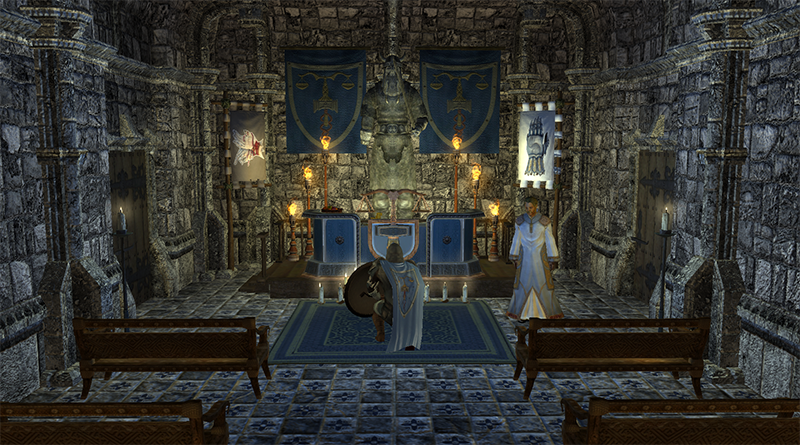
OOC:Original: Tyr's temple in Baldur's Gate has existed for many years, and many Players both currently active and long retired from the Server, adding much Role-play to the Church and Faith of the Even-handed.
This "new" Church aims to continue that legacy, further that legacy, and bring together the many "knight-errants" that continue to act in faith on behalf of all Tyrrans.
Many who follow the faith of Tyr act on their own, but the Church provides a stable base for the religious services and fair judgements (and DM request!).
There is no active PC hierarchy as of yet, only those upholding the Dogma of the Church (as outlined above).
29th June 2024: Steve has handed the reigns of managing this thread to Obvious_Illusion. This initial post has been edited to provide some more information on Tyr and the church, and to update the current members and acknowledge those remembered or retired. Please get in touch with me if you'd like your character included in the current or previous membership.
